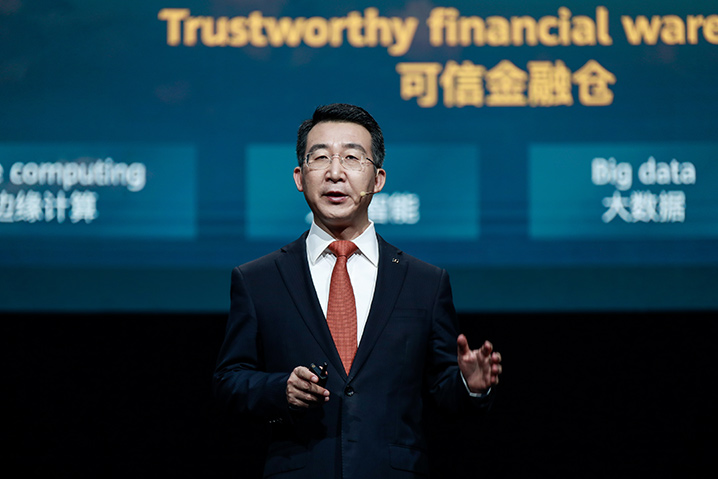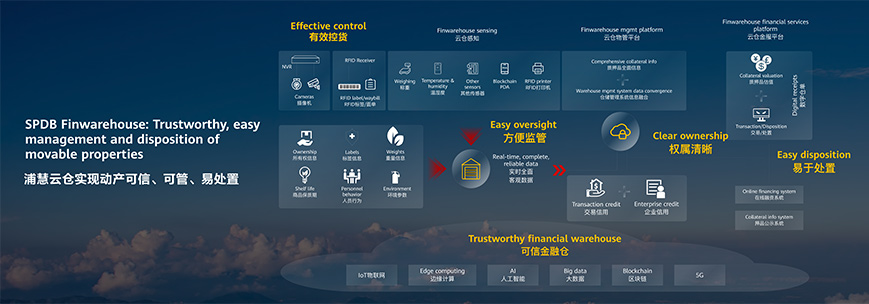Prodotti, soluzioni e servizi per le aziende
[Shenzhen, China, September 23, 2021] Shanghai Pudong Development Bank (SPD Bank) and Huawei presented the SPDB Finwarehouse Solution at HUAWEI CONNECT 2021. The solution is one of the biggest milestones in joint innovation for financial digitalization. It is also a step towards consolidating the Bank of Things, as the solution uses IoT to secure movable property pledges, making every object identifiable, every alarm traceable, and every item trustworthy.
Last year, SPD Bank and Huawei released the Bank of Things White Paper, which proposes a new financial services model and system. Following this, SPD Bank began to apply innovative digital technologies to promote the Bank of Things, partnering with Huawei to "dive into digital". SPDB Finwarehouse is one of the important initiatives that has resulted from this partnership and direction.
The solution is designed for industrial supply chains and is an innovative way to manage pledges for movable warehousing properties. Previously an area of financial services that wasn't seeing extensive digitalization, movable properties represent an innovation market space worth billions of yuan.

Chen Haining, GM of IT Department, SPD Bank
Often, movable properties are subject to several risks. For example, ownership may not be clear, so property is pledged several times. At the same time, supervision companies may not always be completely ethical, which is why adulteration is likely to occur. Even if supervision is precise, it is costly without digital means. And without a disposal platform, goods are difficult to monetize.
In response to these issues, SPD Bank has designed a more precise and trustworthy solution. SPDB Finwarehouse uses RFID, weighing devices, and blockchain PDA devices to record objective information directly at the warehouse. Inbound goods are matched with financing and lending, while outbound goods are linked with repayment. This makes goods supervision a lot easier and more effective.
The solution also helps accurately determine the value of goods. It integrates verified trade, perception, and market information, and uses it to determine ownership, valuation, and efficient disposal. Essentially, logistics, commercial, capital, and information flows become centralized, providing the necessary data to properly valuate movable assets. Both upstream and downstream enterprises can now access accurate financial services, which cover the entirety of the supply chain.

Illustration: SPDB Finwarehouse: Trustworthy, manageable, and easy-to-dispose movable properties
Logistics and warehouses frequently use digital technologies. As such, Huawei and SPD Bank are deploying intelligent IoT devices at warehouses along with introducing AI capabilities and multi-dimensional data verification. This transforms regular warehouses into financial ones, integrating financial services into management and business processes. Based on the HUAWEI CLOUD platform, SPDB Finwarehouse makes every object identifiable, every alarm traceable, and every item trustworthy. The solution features the following technologies:
In the SPDB Finwarehouse Monitoring Center, operators can easily verify the authenticity of inbound goods. They can count cargo stacks through Pangu models and verify them using the scanning code, weight data, and trade background data.
"SPDB Finwarehouse is a pilot digital finance project. We have performed an in-depth evaluation on the needs of the enterprise service market. Now, we need to continue looking for ways to transform our business logic and rebuild our technical capabilities in order to keep up digitalization." — said by Mr. Chen Haining, GM of the IT Department at SPD Bank. He added, "By integrating digital technologies into industries, we can use digital capabilities to drill down into the supply chain scenarios of various real economy industries. SPD Bank looks forward to working with Huawei to integrate finance with the real economy."
In a world where everything is connected, new scenarios and business models will continue to emerge.
"Huawei and SPD Bank will continue to innovate, providing leading technology products and full-stack cloud infrastructure solutions for digital finance upgrades. We will use technology innovation for faster financial services upgrades, working together to further interconnect industries with tailored financial innovation." — said by Mr. Jason Cao, President of Global Financial Business Unit, Huawei Enterprise BG, "Huawei has contributed its full-stack technologies to work on SPDB Finwarehouse with SPD Bank. With our customers, we are diving into digital and promoting the upgrade of digital finance. We hope to drive the real economy forward with the power of finance. Huawei is committed to helping financial institutions as they constantly upgrade their agility, intelligence, industry services, and ecosystem construction. We are helping financial institutions along their digital transformation journey and building a fully connected, intelligent, and ecosystem-based finance industry together."
SPD Bank and Huawei set up a joint innovation lab in 2018, which has led to several successful projects. In August 2020, they signed a comprehensive strategic cooperation agreement, and together published The Bank of Things White Paper — a major milestone. SPD Bank will focus on user experience, apply digital technologies, and innovate with industries such as retail, communications, transportation, and healthcare, to boost the digital economy.
In a world where everything is connected, finance, technology, and industry will be closely linked. Huawei and SPD Bank are drawing on the power of cloud-based FinTech to serve the community, enable customers, and create new industry value.
Huawei hosts HUAWEI CONNECT 2021 online from September 23 to October 31. The theme of this year's event is Dive into Digital. We're going to dive deep into the practical application of technologies like cloud, AI, and 5G in all industries, and how they can make organizations of all shapes and sizes more efficient, more versatile, and ultimately more resilient as we move towards economic recovery.